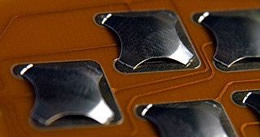A Definition of Metal Dome Copper Flex Membrane Switches
A metal dome copper flex membrane switch contains metal domes, or contacts, mounted to a copper flex substrate. The entire electronic module is encased inside a membrane switch assembly. Metal dome membrane switches are used when designers and electronic engineers desire a tactile response for users. This tactile response is achieved when users press the metal dome membrane switch, compressing the metal dome to the substrate conductor, and resulting in a snapping sound. The tactile response happens nearly simultaneously with the moment of contact.
Various actuation forces are possible, depending on the construction of the metal domes themselves. One advantage of using metal dome membrane switches is that they allow for designers and electronic engineers to choose the metal dome that will result in the actuation force that best suits the application.
Copper flex membrane switches are constructed using either polyester or polyimide as the base material. Copper flex membrane switches are produced by laminating a very thin sheet of copper to the flexible film substrate that is then chemically etched, leaving copper traces. Two disadvantages of copper flex membrane switches is that the process requires chemicals that are not environmentally friendly, and the process is less cost effective than the screen printing process involved in producing silver flex membrane switches.
Types of Copper Flex Membrane Switches
Copper membrane switches may be constructed in one of four ways:
- Single-sided: conductive traces etched on one side of the film substrate
- Double-sided: conductive traces etched on both sides of the film substrate
- Multi-layer: numerous layers with conductive traces are stacked and laminated
- Rigid-flex: a copper flex switch combined with a rigid membrane switch that is laminated
Benefits of Metal Dome Copper Membrane Switches
In general, metal dome membrane switches are well-suited for high-use environments, because metal dome contact assemblies typically deliver 1,000,000 or more switch actuations. They also are appropriate for harsh environments, because metal dome membrane switches are fully enclosed, making them resistant to moisture.
The copper flex used in metal dome copper membrane switches is ideal for smaller designs that require dense circuit patterns or that limit trace routing. Copper flex also accommodates the complex circuit patterns associated with rigid printed circuit boards but provide the flexibility of a membrane switch.
Other benefits of metal dome copper flex membrane switches include:
- High Reliability: copper flex keypads allow for hard soldering active and passive components into the assembly, making them highly reliable and good choices for high-vibration environments as well
- Lower electrical resistance and higher conductivity than silver flex membrane switches
- Possible pitch 0.5m and 0.3mm for ZIF connector
- Thin profiles and flexibility
- Plating options in tin-lead, nickel, or gold
- Pillow or rim-embossed graphic overlays that may be digitally printed, screen printed, or combination of digital and screen printing
- Graphic overlays also may feature transparent and tinted display windows, selective textures, and UV hard-coat surface finishes
- Solid copper traces are heavier and more durable than softer printed silver traces
Backlighting Options for Metal Dome Copper Membrane Switches
There are three common backlighting options available for metal dome copper flex membrane switches.
- Embedded Light Emitting Diodes (LEDs): LEDs may be used as indicator lights, emit little heat, and typically are available in a variety of colors and intensities
- Fiber Optic Backlighting: Fiber optics are a cost effective backlighting option that provide more uniform backlighting across a broader area of the membrane switch keypad and have a longer life than electroluminescent lamps
- Electroluminescent (EL) Backlighting: EL lamps consume little power and provide uniform backlighting of the entire membrane switch, but they require a DC to AC inverter for operation



